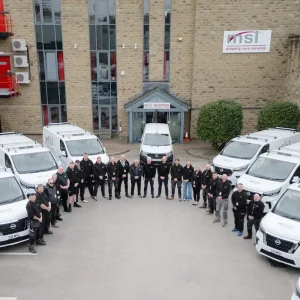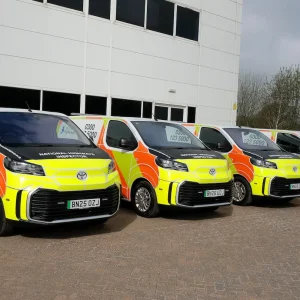 Too many fridge van conversions are of poor quality and do an inadequate job. That’s the view of Alan Lines. He’s secretary of Transfrigoroute, the trade association for the refrigerated transport industry. A well-known figure in the sector, Lines agrees that there are a number of converters who are well established and work to a high standard. Unfortunately too many conversions are executed by corner-cutting under-the-arches cowboys that employ inadequate insulation materials, he believes.
Too many fridge van conversions are of poor quality and do an inadequate job. That’s the view of Alan Lines. He’s secretary of Transfrigoroute, the trade association for the refrigerated transport industry. A well-known figure in the sector, Lines agrees that there are a number of converters who are well established and work to a high standard. Unfortunately too many conversions are executed by corner-cutting under-the-arches cowboys that employ inadequate insulation materials, he believes.
“I know of cases where the curly S-shaped bits of polystyrene foam often packed around fragile goods have been used,” he says. That is despite the fact that a proper level of insulation is vital if the cargo is to be kept at the correct temperature.
Tougher Legislation
He argues that tough legislation should be introduced specifically to police converters activities. For a start, he would like to see all conversions comply with the ATP (Accord Transport Perissable) regulations that govern refrigerated vehicles used on cross-border work.
“ATP sets the standard of insulation that has to be fitted, but does not apply to vehicles that operate solely in the UK,” Lines says. A number of bodybuilders and converters have adopted it voluntarily, however, for everything they do, regardless of whereabouts a vehicle is going to be working.
Chris Berridge, managing director of temperature-controlled vehicles specialist Paneltex, agrees that the rules need tightening. However, he does not believe that ATP as it stands is the entire answer so far as van conversions are concerned.
Star Rating
 “I’d like to see it enhanced with the use of some sort of star rating similar to the one used on domestic fridges,” he says. “That would give buyers an easy way of comparing one vehicle with another. As part of this I’d also like to see some account taken of the vehicle’s carbon footprint and the impact the conversion is having on its fuel consumption.”
“I’d like to see it enhanced with the use of some sort of star rating similar to the one used on domestic fridges,” he says. “That would give buyers an easy way of comparing one vehicle with another. As part of this I’d also like to see some account taken of the vehicle’s carbon footprint and the impact the conversion is having on its fuel consumption.”
Perhaps any star rating could be related to the K factor. When considering the effectiveness of insulation, it’s the K factor figure that matters. It’s a measurement of thermal efficiency, and the lower it is, the better. “A figure of .38 or .39 is what you should be looking for if you’re carrying frozen goods,” says Lines. “However, I’ve seen some refrigerated light commercials on frozen work with a K factor of .9.”
Over-specifying insulation can make sound sense contends Scott Dargan, UK operations director at Carrier Transicold. So can specifying an overnight stand-by system, even if you don’t need one. Both steps may make it easier to sell the vehicle second-hand, although they will of course add to both the front-end cost and the unladen weight.
Dual Compartment
A number of fridge vans are dual compartment, with a section for frozen goods separated from the one intended to accommodate chilled items by a bulkhead. Some types of conversion use a fan to blow icy air from the former into the latter, but Lines is not convinced it is a good idea.
He points to the risk of cross-contamination and the danger that the chilled goods will get too cold. Drawing off cold air from the frozen section could also mean that the frozen cargo will end up being transported at too low a temperature, he adds, and will suffer as a consequence.
Twin Evaporators
 “Having a separate evaporator for each compartment makes much more sense,” he argues. It allows the temperature in each area to be controlled more precisely, although it is of course more expensive than having a fan kit installed.
“Having a separate evaporator for each compartment makes much more sense,” he argues. It allows the temperature in each area to be controlled more precisely, although it is of course more expensive than having a fan kit installed.
“If the goods are all protected by packaging though then there shouldn’t be a danger of items being contaminated,” says Berridge. “Fan kits are reliable, they give adequate though admittedly not precise temperature control, and they don’t require as much maintenance as an evaporator.”
Furthermore, the cold air can be blown into the chilled compartment via carefully-positioned ducting, he says. “The industry has gone beyond simply putting a fan in a bulkhead,” he remarks.
One good example of a firm that’s specified twin evaporators is St Agnes, Cornwall based Doble Quality Foods. It has just added an Iveco Daily 3.5-tonne chassis cab to its 11-strong fleet fitted with an ATP-certified insulated dual-compartment box body with a Hubbard 520 Alpha fridge unit and two evaporators. One is for the -25°C frozen compartment while the other is for its +3°C chilled counterpart.
Sliding Bulkheads
Some dual compartment fridge vehicles have moveable bulkheads. Nothing wrong in that, says Lines, just so long as there is an effective seal between the bulkhead and the body and so long as the bulkhead doesn’t end up positioned too close to an evaporator. “If it is, then the entire refrigeration system may start to defrost,” he warns.
These days Paneltex owns well-known fridge van converter Somers Refrigeration, which means Berridge is well-placed to decide which makes more sense; a van conversion or a refrigerated box body mounted on the back of a chassis cab.
Van or Chassis Cab?
 A fridge box’s advantages include its vertical sides; something that a panel van does not have. Instead, they curve inwards as they meet the roof, a design characteristic usually referred to as tumblehome. “As a consequence you may be able to position four crates width-ways at floor level, but only three further up as you stack them towards the ceiling,” he says. A fridge box offers more usable space and you can have the doors positioned wherever you want them.
A fridge box’s advantages include its vertical sides; something that a panel van does not have. Instead, they curve inwards as they meet the roof, a design characteristic usually referred to as tumblehome. “As a consequence you may be able to position four crates width-ways at floor level, but only three further up as you stack them towards the ceiling,” he says. A fridge box offers more usable space and you can have the doors positioned wherever you want them.
Box bodies can be taken off an old chassis and remounted on a new one once the former has outlived its usefulness, giving them a second life. Furthermore, if they’re damaged in a collision then they’re generally easier to repair than damage to a van conversion.
“If you want to buy a refrigerated box body for use on chilled work then it will typically cost you around £8,000 on a medium-wheelbase chassis compared with around £4,000 to get a medium-wheelbase panel van converted.” Berridge says.
The price gap between the two options narrows if they’re being used on frozen work, however, and chassis cabs are of course cheaper than vans. The possibility of getting a second life out of a fridge box also has to be taken into account.
“Don’t forget though that a van will be more acceptable to the neighbours if the driver is expected to take it home at night,” says Dargan. Don’t forget either that a van is likely to be more fuel-frugal than a chassis cab plus box.
Removable Insulation
Although they may not always be as thermally efficient as fixed insulation, clip-in/clip-out insulated linings for vans can make accident damage easier to repair. That’s because their use means that fixed insulation does not have to be torn out and replaced as part of the repair process.
They have the further advantage that they can — in theory at least — be transferred to your next van, allowing your old vehicle to be sold second-hand for ambient work. That could mean incidentally that it commands a better price. There are a lot more people around who want standard vans than there are people who want refrigerated examples. Even those who require the latter are often wary about buying used ones in case they harbour faults; worn-out compressors, poorly-repaired insulation and so on.
Direct-Drive
While electric fridge units are available that can be run off the engine’s alternator, their capacity is limited and they’re usually only found in small vans on chilled work. Most refrigerated light commercials employ compressors that are driven directly off the engine.
While the condenser usually sits on the vehicle’s roof, in some cases it may be possible to position it under the bonnet. That means there will be no need to alter the roof to accommodate it. Fuel consumption should be better too because a roof-mounted unit can create aerodynamic drag, although that can be counteracted by fitted a sculpted fairing.
Condensers positioned under the bonnet have the further advantage that they are less vulnerable to accidental damage. “However, issues with under-bonnet airflow mean that they’re generally only suitable for chilled applications,” Dargan contends.
Maintenance
Like air-conditioning systems, fridge units require periodic attention. “They usually need servicing a couple of times a year no matter whether they are electric or direct-drive,” says Norman Highnam, contracts director at major league Thermo King dealer, Marshall Thermo King. “A service generally takes an hour to an hour-and-a-half.”
It’s not just the refrigeration system that needs looking after. Cracks in the insulation need to be repaired promptly because they can become breeding grounds for germs; a health hazard if you happen to be carrying food.
Eutectics
 Eutectic beams represent another approach to light commercial refrigeration. While they’re heavy, and not suitable for all types of work, they have the advantages of silent operation and low maintenance requirements. Frozen overnight while the vehicle is stationary using off-peak electricity, the beams are filled with a special gel that absorbs heat.
Eutectic beams represent another approach to light commercial refrigeration. While they’re heavy, and not suitable for all types of work, they have the advantages of silent operation and low maintenance requirements. Frozen overnight while the vehicle is stationary using off-peak electricity, the beams are filled with a special gel that absorbs heat.
 Fridge system maker Hubbard recently fitted them to the fridge boxes mounted on a pair of Volkswagen Crafter CR50 5.0-tonners operated by Cornish clotted cream maker Rodda. Although the load area’s doors may be opened anywhere from 40 to 70 times during a delivery run, the tubes help the vehicles keep the cargo at an even temperature of +4°C says Rodda’s transport and logistics manager, Simon Barker. “They’re competent and cost-effective,” he says.
Fridge system maker Hubbard recently fitted them to the fridge boxes mounted on a pair of Volkswagen Crafter CR50 5.0-tonners operated by Cornish clotted cream maker Rodda. Although the load area’s doors may be opened anywhere from 40 to 70 times during a delivery run, the tubes help the vehicles keep the cargo at an even temperature of +4°C says Rodda’s transport and logistics manager, Simon Barker. “They’re competent and cost-effective,” he says.
Monitoring
Monitoring the cargo’s temperature is vitally important. If it suddenly plummets then the goods could be rejected by the customer. Onboard monitoring devices are often fitted, but the temperature can be monitored remotely too using a telematics system. If it fluctuates wildly then the transport manager can instruct the driver to return to home base immediately, or to rendezvous with a refrigeration engineer somewhere to get the fault rectified.
Verdict
Whichever type of refrigeration package you opt for, you should of course ensure that it has sufficient capacity to meet your needs. You will need to take into account the temperature at which the cargo has to be maintained, the size of the load area and how many times its doors will be opened and shut during a typical delivery run. Be guided by the bodybuilder (use someone reputable) and the fridge unit manufacturer — GAH is a name to watch out for as well as Hubbard, Carrier Transicold and Thermo King — before making your final decision and don’t forget that a refrigeration system cannot compensate for poor insulation. If it tries to do so, then up will go your fuel consumption; bad news given the price of diesel.





